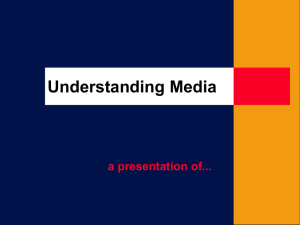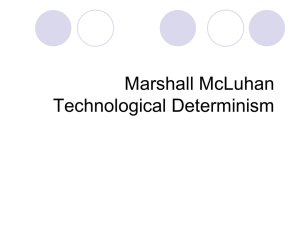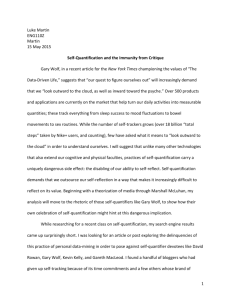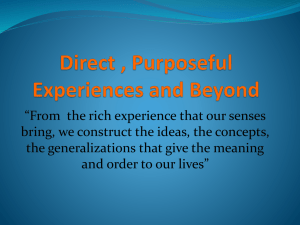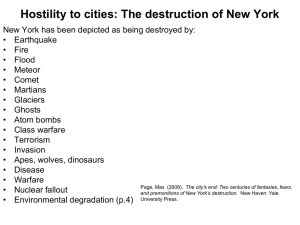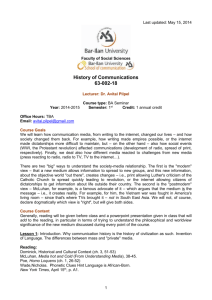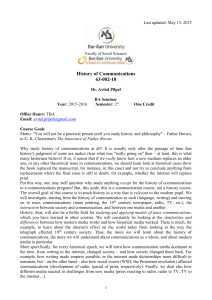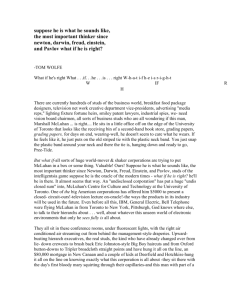What is Media(수정본)
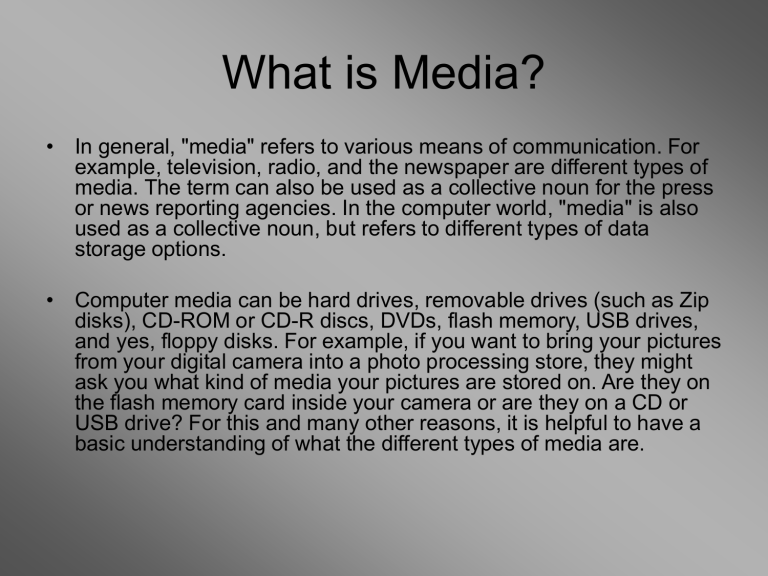
What is Media?
• In general, "media" refers to various means of communication. For example, television, radio, and the newspaper are different types of media. The term can also be used as a collective noun for the press or news reporting agencies. In the computer world, "media" is also used as a collective noun, but refers to different types of data storage options.
• Computer media can be hard drives, removable drives (such as Zip disks), CD-ROM or CD-R discs, DVDs, flash memory, USB drives, and yes, floppy disks. For example, if you want to bring your pictures from your digital camera into a photo processing store, they might ask you what kind of media your pictures are stored on. Are they on the flash memory card inside your camera or are they on a CD or
USB drive? For this and many other reasons, it is helpful to have a basic understanding of what the different types of media are.
‘ The Media Is An Extension
Of Our Central Nervous
System’
What Does This Mean?
Who Thought This Up?
What Does It Relate To?
The Theory
Marshall McLuhan
• One of Marshall McLuhans main ideas was that the medium is the message: a mediums real message is the medium itself. It is not the content which is decisive, but the media itself which has influence over society.
• McLuhan believed that the more technologically advanced society becomes, the more individuals become isolated. Modern media is depersonalised and each extension of man through technology adds to the numbness of the individual and society. Modern media has caused lives and cultures to become homogenized.
• McLuhan defined ‘hot’ and ‘cold’ media: hot media has a strong influence and a destructive power whilst having a low level of interaction. Cold media has a weak influence and demands a high level of interaction.
‘ The Oracle of the Electronic
Age’
• McLuhan made the concept of a ‘global village’, interconnected by an electronic nervous system, part of our popular culture before it existed:
“After 3000 years of the extension of specialisation by the technical extension of our bodies, our world seems to be compressing in an opposite development”. (Because of broadcasting etc. space and time are almost obsolete) “Electrically contracted, the world is now only a village.”
• McLuhan had a broad definition of media: “any technology that…creates extensions of the human body and senses.”
This would include clothing as an extension of the skin, the wheel as an extension of the foot and the book as an extension of the eye.
He believed that these technological extensions amplify a particular human sense to the detriment of the others, making an individual dazed, deaf, dumb or blind. This effectively interferes with the sensory balance of individuals and affects the sensibilities of their societies.
• Electronic media extended the entire human nervous system (all five senses simultaneously) rather than just the eye as print media had done.
Electronic media restored the equilibrium of the senses and extroverted the human nervous senses out into the world creating a planet-wide neural consciousness.
• “The electronically induced technological extensions of our central nervous systems…are immersing us in a whirlpool of information…the aloof and dislocated role of the literate man of the Western world is succumbing to the new intense depth participation…decentralising – rather than enlarging – the family of man into a new state of multitudinous tribal existences.” – McLuhan.
• “Today, after more than a century of electronic technology, we have extended our central nervous system itself in a global embrace, abolishing both space and time as far as our planet is concerned.” –
McLuhan
‘Biological senses’ involve us in our situation
‘Extended senses’ lead to detachment.
Our senses are used to access information: telephone, radio, television, newspapers etc.
‘The Media Is An Extension Of
Our Central Nervous System’
“Electronic technology would seem to render individualism obsolete and corporate interdependence mandatory.”
Speed of access with the internet etc mean communication with people globally is as easy as with neighbours.
• “ Multimedia is the seamless integration of data, text images of all kinds and sound within a single digital information environment.”
- Feldman, 1994.
• We extend ourselves in order to receive media and we do this through communication and interaction.
• One model of media interaction, by Levy, is as follows:
Many to Many –
One to Many – we all have separation potential to be between transmitters transmitters &
& receivers. receivers. E.g. TV,
E.g. Internet.
radio.
• Therefore, when we receive media from a one to many interaction, we can transmit that media information onto others.
So the media becomes a part of ourselves and we become a part in the media process.
We become a receiver and a transmitter and by communicating with others we introduce the many to many interaction. By doing this we also extend ourselves in order to communicate and interact.
• This is shown in Aristotle's model of human communication:
Speaker
Addressed
Subject Person
Yourself Media Info Other Person
How Can This
Be Interpreted
& Represented?
How Do We
Consume The Media?
It Is Absorbed Through
Our Body & Our Senses
SIGHT
TASTE
The
Senses
HEARING
SMELL TOUCH
Our Senses &
The Media
How ‘the media is an extension of our central nervous system’…
Sight –
Perception, Visibility, Representation,
Vision
Hearing –
Detection
Reception
Communication
Absorption
Examination
Consideration
Touch –
Contact, Converge, Manipulate,
Influence
Smell –
Inhale
Distinguish
Ascertain
Extract
Taste –
Suggestion
Appetizing
Appreciation
Cultivation
Experience
Savour
Bibliography
• The Medium Is The Message, M. McLuhan & Q. Fiore, 1967
(The Penguin Press)
• www.aber.ac.uk/media/Students/bas9401.html
• www.hans-hass.de/Englisch/Energon/6_Appendix_3.html
• www.labyrinth.net.au/~saul/essays/mcluhan.html
• www.aber.ac.uk/media/Students/ram0202.html
• www.destinationkm.com/articles/default.asp?ArticleID=1058
• http://geoffbarton.co.uk/files/studentresources/Communication/Technology/Marshall%20McLuhan
%20Summary.doc
번역의 분류
번역이 실제 이루어지는 양상을 기준으로
번역을 분류하면 다음과 같이
3
가지 범주로
구분할 수 있다
.
① 출판번역
② 비즈니스 번역
③ 미디어 번역
출판번역
출판번역이란 주로 출판사의 의뢰를 받아 전문번역가가 출판을
목적으로 하는 번역을 말하는데 주로 각 분야의 해외서적들을 번역하게
된다 . 출판번역 시장은 현재 전체 출판시장의 약 20% 를 점유하고 있고 ,
그 비중은 앞으로 계속 늘어날 것으로 기대된다 . 출판번역의 세계는
크게 " 문학번역 " 과 비문학 번역 " 으로 나눌 수 있다 . " 비문학 번역 " 은 주로
대학교수 등의 학자에 의해서 이루어지는 학술서의 번역이 주류를
이룬다 . 출판번역의 커다란 특징은 무엇보다도 번역해야 할 원문의 양이
많다는 것이다 . 또한 출판번역의 결과물은 우리말로 쓰인 서적으로서도
손색이 없어야 하므로 표현력과 문장력 , 어휘력 등을 겸비한 높은
수준의 번역가에 의해서 이루어져야 한다 .
비즈니스 번역
비즈니스 번역이란 기업체 , 관공서 등에서 업무수행을 위하여
이루어지는 제반 번역을 말한다 . 비즈니스 번역의 대상은 기획서 ,
계약서 , 제품 매뉴얼 , 클레임 문서 , 연설문 , 회의록 등 대단히 넓은
분야의 문건이 되므로 해당 영역에 관한 고도의 전문지식을 요구하는
경우가 대부분이다 . 비즈니스 번역은 그 활용도가 높은 경우 일반
기업체나 관공서 등에 의해 고용된 전문 번역가에 의해 이루어지기도
하고 , 해당 기관의 직원의 손에 의해 이루어지기도 한다 . 간헐적으로
비즈니스 번역 서비스가 필요한 경우 전문 번역 에이전시의 손을
빌리기도 한다 .
미디어번역
우리의 주된 관심사인 미디어 번역이란 영화 , 비디오 , 신문 , 잡지 등의
대중매체에 관련된 제반 번역을 일컫는다 . 미디어의 속성상 전문 출판번역의
결과물처럼 오랫동안 보관을 요하는 것이 아니라 해당 매체의 영향력이
행사되는 비교적 짧은 기간만을 위하여 이루어지는 번역이다 . 그러다 보니 전문
출판번역의 경우와 같이 많은 시간이 주어지는 상태에서 번역이 이루어지지는
않는다 . 그러므로 미디어 번역가는 해당 분야에 대한 식견과 번역 노하우를 어느
정도 갖추고 있어야 하는 경우가 대부분이다 . 그러나 다행하게도 다른 두 번역
분야와는 달리 일반대중을 대상으로 하는 미디어 매체의 속성상 지극히 난해한
내용이나 전문적인 내용을 번역해야 하는 경우는 없다 . 다만 일반 대중의 최근
취향과 시사성 있는 세상사에 대한 정보에는 정통해 있어야만 원활한 번역을 할
수 있다 .
